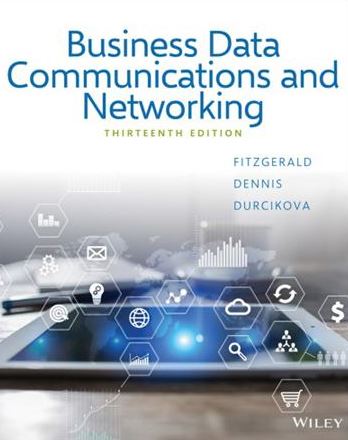Business Data Communications and Networking 13th Edition, ISBN-13: 978-1119368830
[PDF eBook eTextbook]
400 pages
Publisher: Wiley (November 15, 2017)
Language: English
ISBN-10: 1119441110
ISBN-13: 978-1119368830
As the world grows increasingly interconnected, data communications has become a critical aspect of business operations. Wireless and mobile technology allows us to seamlessly transition from work to play and back again, and the Internet of things has brought our appliances, vehicles, and homes into the network; as life increasingly takes place online, businesses recognize the opportunity for a competitive advantage. Today’s networking professionals have become central to nearly every aspect of business, and this book provides the essential foundation needed to build and manage the scalable, mobile, secure networks these businesses require. Although the technologies evolve rapidly, the underlying concepts are more constant.
This book combines the foundational concepts with practical exercises to provide a well-grounded approach to networking in business today. Key management and technical issues are highlighted and discussed in the context of real-world applications, and hands-on exercises reinforce critical concepts while providing insight into day-to-day operations. Detailed technical descriptions reveal the tradeoffs not presented in product summaries, building the analytical capacity needed to understand, evaluate, and compare current and future technologies.
Table of contents
About the Authors v
Preface vi
PART ONE: INTRODUCTION 1
Chapter 1: Introduction to Data Communications 1
1.1 Introduction 1
1.2 Data Communications Networks 4
1.2.1 Components of a Network 4
1.2.2 Types of Networks 5
1.3 Network Models 7
1.3.1 Open Systems Interconnection Reference Model 7
1.3.2 Internet Model 9
1.3.3 Message Transmission Using Layers 10
1.4 Network Standards 13
1.4.1 The Importance of Standards 13
1.4.2 The Standards-Making Process 13
1.4.3 Common Standards 15
1.5 Future Trends 16
1.5.1 Wireless LAN and BYOD 16
1.5.2 The Internet of Things 17
1.5.3 Massively Online 17
1.6 Implications for Cyber Security 18
PART TWO: FUNDAMENTAL CONCEPTS 25
Chapter 2: Application Layer 25
2.1 Introduction 25
2.2 Application Architectures 26
2.2.1 Host-Based Architectures 27
2.2.2 Client-Based Architectures 28
2.2.3 Client-Server Architectures 28
2.2.4 Cloud Computing Architectures 31
2.2.5 Peer-to-Peer Architectures 33
2.2.6 Choosing Architectures 34
2.3 World Wide Web 35
2.3.1 How theWebWorks 35
2.3.2 Inside an HTTP Request 36
2.3.3 Inside an HTTP Response 37
2.4 Electronic Mail 39
2.4.1 How EmailWorks 39
2.4.2 Inside an SMTP Packet 42
2.4.3 Attachments in Multipurpose Internet Mail Extension 43
2.5 Other Applications 43
2.5.1 Telnet 44
2.5.2 Instant Messaging 45
2.5.3 Videoconferencing 45
2.6 Implications for Cyber Security 47
Chapter 3: Physical Layer 57
3.1 Introduction 57
3.2 Circuits 59
3.2.1 Circuit Configuration 59
3.2.2 Data Flow 60
3.2.3 Multiplexing 60
3.3 CommunicationMedia 63
3.3.1 Twisted Pair Cable 63
3.3.2 Coaxial Cable 64
3.3.3 Fiber-Optic Cable 64
3.3.4 Radio 65
3.3.5 Microwave 66
3.3.6 Satellite 66
3.3.7 Media Selection 68
3.4 Digital Transmission of Digital Data 69
3.4.1 Coding 69
3.4.2 Transmission Modes 69
3.4.3 Digital Transmission 71
3.4.4 How Ethernet Transmits Data 72
3.5 Analog Transmission of Digital Data 73
3.5.1 Modulation 73
3.5.2 Capacity of a Circuit 76
3.5.3 How Modems Transmit Data 76
3.6 Digital Transmission of Analog Data 77
3.6.1 Translating from Analog to Digital 77
3.6.2 How Telephones Transmit Voice Data 77
3.6.3 How Instant Messenger Transmits Voice Data 79
3.6.4 Voice over Internet Protocol (VoIP) 80
3.7 Implications for Cyber Security 80
Chapter 4: Data Link Layer 88
4.1 Introduction 88
4.2 Media Access Control 89
4.2.1 Contention 89
4.2.2 Controlled Access 89
4.2.3 Relative Performance 90
4.3 Error Control 91
4.3.1 Sources of Errors 91
4.3.2 Error Prevention 93
4.3.3 Error Detection 94
4.3.4 Error Correction via Retransmission 95
4.3.5 Forward Error Correction 95
4.3.6 Error Control in Practice 97
4.4 Data Link Protocols 97
4.4.1 Asynchronous Transmission 97
4.4.2 Synchronous Transmission 98
4.5 Transmission Efficiency 101
4.6 Implications for Cyber Security 103
Chapter 5: NETWORK AND TRANSPORT LAYERS 110
5.1 Introduction 110
5.2 Transport and Network Layer Protocols 112
5.2.1 Transmission Control Protocol (TCP) 112
5.2.2 Internet Protocol (IP) 113
5.3 Transport Layer Functions 114
5.3.1 Linking to the Application Layer 114
5.3.2 Segmenting 115
5.3.3 Session Management 116
5.4 Addressing 119
5.4.1 Assigning Addresses 120
5.4.2 Address Resolution 125
5.5 Routing 127
5.5.1 Types of Routing 128
5.5.2 Routing Protocols 130
5.5.3 Multicasting 132
5.5.4 The Anatomy of a Router 133
5.6 TCP/IP Example 134
5.6.1 Known Addresses 136
5.6.2 Unknown Addresses 137
5.6.3 TCP Connections 138
5.6.4 TCP/IP and Network Layers 139
5.7 Implications for Cyber Security 141
PART THREE: NETWORK TECHNOLOGIES 159
Chapter 6: Network Design 159
6.1 Introduction 159
6.1.1 Network Architecture Components 159
6.1.2 The Traditional Network Design Process 161
6.1.3 The Building-Block Network Design Process 162
6.2 Needs Analysis 164
6.2.1 Network Architecture Component 165
6.2.2 Application Systems 166
6.2.3 Network Users 166
6.2.4 Categorizing Network Needs 166
6.2.5 Deliverables 167
6.3 Technology Design 168
6.3.1 Designing Clients and Servers 168
6.3.2 Designing Circuits 168
6.3.3 Network Design Tools 170
6.3.4 Deliverables 171
6.4 Cost Assessment 171
6.4.1 Request for Proposal 171
6.4.2 Selling the Proposal to Management 173
6.4.3 Deliverables 173
6.5 Implications for Cyber Security 173
Chapter 7: Wired and Wireless Local Area Networks 177
7.1 Introduction 177
7.2 LAN Components 178
7.2.1 Network Interface Cards 179
7.2.2 Network Circuits 179
7.2.3 Network Hubs, Switches, and Access Points 180
7.2.4 Network Operating Systems 183
7.3 Wired Ethernet 184
7.3.1 Topology 184
7.3.2 Media Access Control 187
7.3.3 Types of Ethernet 188
7.4 Wireless Ethernet 189
7.4.1 Topology 189
7.4.2 Media Access Control 189
7.4.3 Wireless Ethernet Frame Layout 190
7.4.4 Types ofWireless Ethernet 191
7.4.5 Security 192
7.5 The Best Practice LAN Design 193
7.5.1 Designing User Access withWired Ethernet 194
7.5.2 Designing User Access withWireless Ethernet 195
7.5.3 Designing the Data Center 197
7.5.4 Designing the e-Commerce Edge 199
7.5.5 Designing the SOHO Environment 200
7.6 Improving LAN Performance 202
7.6.1 Improving Server Performance 203
7.6.2 Improving Circuit Capacity 204
7.6.3 Reducing Network Demand 204
7.7 Implications for Cyber Security 205
Chapter 8: Backbone Networks 214
8.1 Introduction 214
8.2 Switched Backbones 215
8.3 Routed Backbones 218
8.4 Virtual LANs 221
8.4.1 Benefits of VLANs 221
8.4.2 How VLANsWork 223
8.5 The Best Practice Backbone Design 226
8.6 Improving Backbone Performance 227
8.6.1 Improving Device Performance 227
8.6.2 Improving Circuit Capacity 228
8.6.3 Reducing Network Demand 228
8.7 Implications for Cyber Security 228
Chapter 9: Wide Area Networks 237
9.1 Introduction 237
9.2 Dedicated-Circuit Networks 238
9.2.1 Basic Architecture 238
9.2.2 T-Carrier Services 241
9.2.3 SONET Services 243
9.3 Packet-Switched Networks 243
9.3.1 Basic Architecture 243
9.3.2 Frame Relay Services 245
9.3.3 IP Services 246
9.3.4 Ethernet Services 246
9.4 Virtual Private Networks 247
9.4.1 Basic Architecture 247
9.4.2 VPN Types 248
9.4.3 How VPNsWork 248
9.5 The Best PracticeWAN Design 251
9.6 ImprovingWAN Performance 252
9.6.1 Improving Device Performance 252
9.6.2 Improving Circuit Capacity 253
9.6.3 Reducing Network Demand 253
9.7 Implications for Cyber Security 254
Chapter 10: The Internet 265
10.1 Introduction 265
10.2 How the InternetWorks 266
10.2.1 Basic Architecture 266
10.2.2 Connecting to an ISP 268
10.2.3 The Internet Today 269
10.3 Internet Access Technologies 270
10.3.1 Digital Subscriber Line 270
10.3.2 Cable Modem 271
10.3.3 Fiber to the Home 273
10.3.4 WiMax 274
10.4 The Future of the Internet 274
10.4.1 Internet Governance 274
10.4.2 Building the Future 276
10.5 Implications for Cyber Security 277
PART FOUR: NETWORK MANAGEMENT 284
Chapter 11: Network Security 284
11.1 Introduction 284
11.1.1 Why Networks Need Security 286
11.1.2 Types of SecurityThreats 286
11.1.3 Network Controls 287
11.2 Risk Assessment 288
11.2.1 Develop Risk Measurement Criteria 289
11.2.2 Inventory IT Assets 290
11.2.3 Identify Threats 291
11.2.4 Document Existing Controls 293
11.2.5 Identify Improvements 296
11.3 Ensuring Business Continuity 296
11.3.1 Virus Protection 296
11.3.2 Denial-of-Service Protection 297
11.3.3 Theft Protection 300
11.3.4 Device Failure Protection 301
11.3.5 Disaster Protection 302
11.4 Intrusion Prevention 305
11.4.1 Security Policy 306
11.4.2 Perimeter Security and Firewalls 306
11.4.3 Server and Client Protection 312
11.4.4 Encryption 315
11.4.5 User Authentication 321
11.4.6 Preventing Social Engineering 324
11.4.7 Intrusion Prevention Systems 325
11.4.8 Intrusion Recovery 327
11.5 Best Practice Recommendations 328
11.6 Implications for Your Cyber Security 330
Chapter 12: Network Management 340
12.1 Introduction 340
12.2 Designing for Network Performance 341
12.2.1 Managed Networks 341
12.2.2 Managing Network Traffic 345
12.2.3 Reducing Network Traffic 346
12.3 Configuration Management 349
12.3.1 Configuring the Network and Client Computers 349
12.3.2 Documenting the Configuration 350
12.4 Performance and Fault Management 351
12.4.1 Network Monitoring 351
12.4.2 Failure Control Function 353
12.4.3 Performance and Failure Statistics 355
12.4.4 Improving Performance 358
12.5 End User Support 358
12.5.1 Resolving Problems 358
12.5.2 Providing End User Training 360
12.6 Cost Management 360
12.6.1 Sources of Costs 360
12.6.2 Reducing Costs 363
12.7 Implications for Cyber Security 364
Appendices (Online)
Glossary (Online)
Index 373
New to this Edition:
– Updated technologies, questions, and hands-on activities that reflect the current state of the field
– New discussion of individual and organizational cybersecurity implications for each chapter’s major topics
– Clearer, more streamlined explanation of TCP/IP, and coverage of the newest cybersecurity threats and responses
Features
– Explains how networks work, the technologies used, and the security and management methods required for today’s businesses
– Covers network design, analysis, hardware, software, and more
– Provides best practice recommendations for risk assessment, network protection, and intrusion prevention based on up-to-date threats
– Distinguishes the uses, features, and architecture of wired and wireless local area, wide area, and backbone networks
What makes us different?
• Instant Download
• Always Competitive Pricing
• 100% Privacy
• FREE Sample Available
• 24-7 LIVE Customer Support









Reviews
There are no reviews yet.